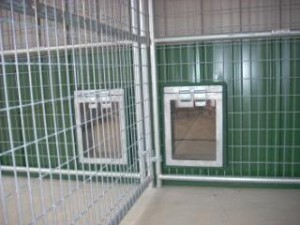A dog on the loose is its own worst enemy. How many times have you seen a dog running about the neighborhood, digging in someone’s garbage cans? Or worse yet, getting hit by a car?
Even in the country, a dog should have a place to go, where it will be protected from the weather, bugs and disease. These are just a few of the reasons why it’s so important to provide a dog with a permanent home.
There are two routes a person can take when building a doghouse. It can be either a free-standing structure, or it can be built inside a shed, garage, or other building, where it can double as a work bench.
The advantage of having an indoor house is that when feeding the dog or taking it out, it’s readily accessible from the inside. That’s a big advantage with the weather extremes in the Northland.
The house doesn’t have to be that big—a 3-foot-6-inch by 3-foot-6-inch structure is plenty big. Most people over-design their doghouse. You want it fairly compact and insulated. You want to allow the dog to keep a warm environment. If it gets too big, the house won’t retain the dog’s body heat.
Sleep quarters
When building the house inside a garage, I recommend elevating half of the floor area for the dog as a sleeping area. I use 2 inches of Styrofoam between the platform and the floor for insulation.
Do not use bedding. Electric heat mats are chew proof and energy efficient (60 watts). They’re clean, don’t collect moisture, are washable, and more importantly, I find the dogs are more content, eat less dog food, and, in general, are more healthy. The mats cost about $150.
If a person opts for an outdoor doghouse, it should be even smaller than an indoor one—usually no bigger than 30 inches by 36 inches. It also should have a pitched roof that’s removable to allow for cleaning and ventilation.
 For bedding, an eclectic heat mat is preferable. Never use cedar shaving, that’s the worst thing you can do—it can really screw up a dogs nose.
For bedding, an eclectic heat mat is preferable. Never use cedar shaving, that’s the worst thing you can do—it can really screw up a dogs nose.
Either type of doghouse should be equipped with a dog door (see www.gundoghousedoor.com).
Whether the doghouse is inside a building or a stand alone, it should have an adjoining kennel run. It generally should have a concrete floor, preferably 4-footby- 10-foot. That’s plenty big, you have to understand it’s just an area for the dog to get fresh air and very seldom used as a bathroom. It’s not an exercise area.
The run should be enclosed with a galvanized wire fence (1 3/8-inch posts) and be at least 5 ½ to 6 feet high. Many dogs can easily jump a 6-foot fence. A cover will keep out the friendly, neighborhood males.
If a concrete run isn’t feasible, dig out a run and fill it with sand, then cover it with 1-inch-by-6-inch-by-12- inch patio block. It makes a nice maintenance surface.
The biggest advantage of a concrete floor is that its easy to clean. A sun baked concrete floor also kills parasites.
While they will make a dog’s life more comfortable and your maintenance chores simplified, there’s a better reason for having a permanent doghouse and kennel run—the dog will train easier.
The biggest advantage from a training standpoint is you’re eliminating the dog’s opportunity to get into trouble. If he’s supervised, he’s not picking up bad habits.
Things to keep in mind before building a shelter
If designing an outdoor doghouse, an owner should keep in mind the following special needs.
- The doghouse should be raised off the ground to avoid moisture.
- It should be protected from the wind.
- It should have outside shade in the summer.
- It should be painted with nontoxic paint, preferably a lighter color so it doesn’t absorb the heat.
- It should have its edges protected with metal sheet-rocked corners, so the dog doesn’t chew them up.
For more information on a variety of topics, including kennel drainage, kennel santiation, building a doghouse, kennel construction, cold/warm weather care, etc. go to www.gundoghousedoor.com.
